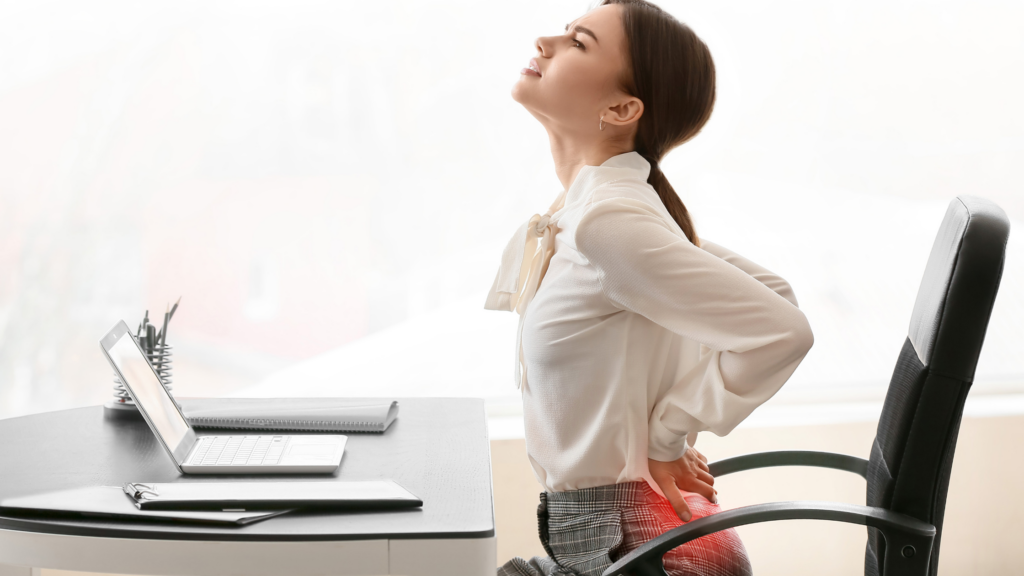We spend a large portion of our day sitting—whether it’s at school, at work, or relaxing at home. While sitting might seem harmless, sitting for long periods can seriously harm your lumbar discs, the discs located in your lower back. Our spine is designed to be flexible, strong, and support our movements, but sitting for too long without breaks can cause significant damage to the lumbar discs over time.
What are Lumbar Discs?
Before we dive into how sitting harms your discs, it’s important to understand what lumbar discs are. Lumbar discs are located between the vertebrae (bones) in your lower back and act like cushions or shock absorbers. Each disc has a tough outer layer called the annulus fibrosus and a jelly-like center called the nucleus pulposus. When we move, sit, or lift things, these discs take on the forces and pressures, helping protect our spine and making sure it stays strong and flexible.
How Sitting Affects the Lumbar Discs
When we sit for long periods without moving, we place a lot of pressure on the lumbar discs. While standing, the weight of your body is distributed more evenly across your spine. But when you sit, especially if you slouch or lean forward, much of the force gets shifted to the back wall of the discs. Over time, this can lead to disc damage.
One of the main problems that arise from sitting too long is how the pressure is displaced to the back of the disc. When this happens, small cracks, or fissures, can form in the outer layer of the disc (the annulus fibrosus). These fissures weaken the disc over time, and as the pressure continues to push against the back of the disc, it can start to bulge out. This is called a disc bulge.
If the pressure continues, the bulging disc can become a disc protrusion, where the disc’s jelly-like center (the nucleus pulposus) pushes more into the weakened area. This can eventually lead to a disc herniation, where the inner part of the disc breaks through the outer layer. The most severe form of this is a disc extrusion, where the inner part of the disc leaks out into the spinal canal, potentially pressing on nerves and causing pain, numbness, or weakness in the legs.
The Importance of Movement: Improving pH Inside the Disc
One way to protect the lumbar discs from this kind of damage is by simply standing up and moving around. Even a brief standing break can have a positive impact on the discs in your lower back. This is because movement helps improve the health of your discs by promoting better circulation of fluids and nutrients. When you sit for too long, the pH inside the disc can become more acidic, which makes it harder for the disc to stay healthy. However, when you stand up or walk around, the pH inside the disc improves, creating a healthier environment for the disc and reducing the chances of damage.
Five Changes to Protect Your Lumbar Discs from Sitting
The good news is that there are simple changes you can make to protect your lumbar discs from the harmful effects of uninterrupted sitting. Here are five suggestions to help lessen the risk of disc injuries:
1. Take Frequent Breaks
One of the easiest ways to protect your lumbar discs is to take frequent breaks from sitting. Aim to stand up and move around if you’ve been sitting for 30 minutes. You don’t need to go far—just getting up, stretching, or walking around your room or office can reduce the pressure on your lumbar discs and help prevent damage.
2. Practice Good Posture
How you sit makes a big difference in the amount of pressure placed on your lumbar discs. Try to sit with your back straight, your shoulders relaxed, and your feet flat on the floor. Avoid slouching or leaning forward, as this increases the pressure on the back wall of the discs. You might also want to consider using a chair with lumbar support or placing a small pillow behind your lower back to encourage better posture.
3. Use an Ergonomic Chair
An ergonomic chair is designed to support your body in a way that reduces stress on your spine and discs. Look for a chair that has adjustable height and backrest, as well as lumbar support to help keep your lower back in the right position. Sitting in an ergonomic chair can help evenly distribute the weight and pressure on your discs, protecting your lumbar spine from excessive strain.
4. Try a Standing Desk
If you spend a lot of time working at a desk, consider using a standing desk, which allows you to alternate between sitting and standing throughout the day. By standing for parts of your workday, you can relieve some of the pressure on your lumbar discs. If you can’t get a standing desk, even standing up to stretch or walk around every 30 minutes can make a big difference.
5. Exercise Regularly
Strengthening the muscles around your spine and core can help take some of the pressure off your lumbar discs. Exercises like walking, swimming, or yoga can improve your posture, flexibility, and muscle strength, which will help support your spine and reduce the risk of disc injuries. Stretching exercises, especially those that focus on the lower back and hamstrings, can also help relieve tension and improve mobility, reducing the strain on your discs from sitting.
Conclusion
Uninterrupted sitting puts significant pressure on your lumbar discs, which can lead to serious disc injuries like bulges, protrusions, herniations, and extrusions. The pressure displaced to the back wall of the disc can cause cracks, weakening the disc over time. However, by making simple changes like taking regular breaks from uninterrupted sitting, practicing good posture, using ergonomic chairs, and staying active, you can reduce the risk of harming your lumbar discs and keep your spine healthy for years to come.

